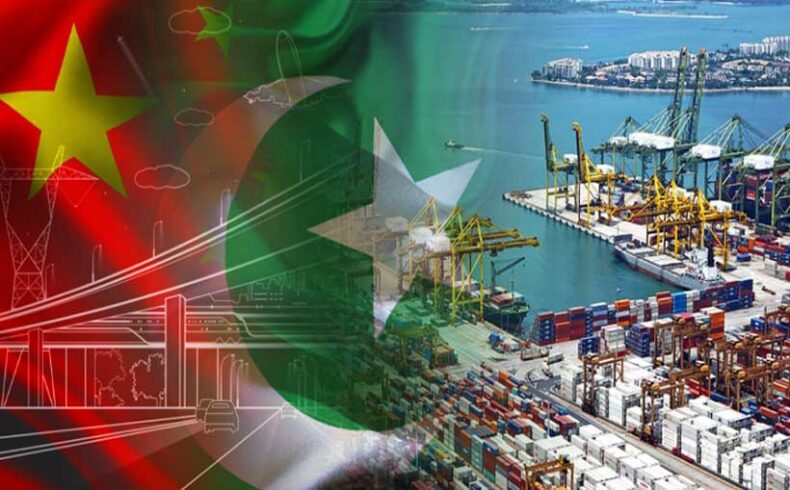Prime Minister (PM) Shehbaz Sharif’s recent significant trip to China is expected to hasten the infrastructure projects on a fast track under the CPEC, where the construction of the deep-sea port Gwadar and other sizable projects will take place. Both countries have decided to boost their relations through CPEC. It is assumed that the restart of CPEC will ultimately aid in bolstering Pakistan’s fragile economy.
The China-Pakistan Economic Corridor (CPEC) and the infrastructure development for the Gwadar Sea Port have both been requested by Chinese President Xi Jinping to the Pakistan Prime Minister, who has also been offered financial support to stabilize the Pak economy.

On Wednesday, China gave Pakistan its assurance that it would continue to support the nation’s long-term economic and strategic initiatives, including the expansion of the China-Pakistan Economic Corridor (CPEC) and the Main Line-1 (ML-1) rail line, as well as a new package of assistance worth RMB 500 million for flood relief efforts.
These promises were purportedly given by Chinese President Xi Jinping and Premier Li Keqiang to Prime Minister Shehbaz Sharif during separate meetings at the People’s Great Hall in Beijing, according to the Prime Minister’s Office (PMO).
Pakistan Meeting with Chinese counterpart
PM Sharif and his Chinese counterpart Li Keqiang decided to expand the CPEC in addition to ensuring the swift completion of projects associated with the corridor during their meeting. The PM was accorded a guard of honour and a warm greeting by Premier Keqiang at the People’s Great Hall.
Furthermore, delegation-level negotiations between the two parties were presided over by their respective leaders. In addition, PM Sharif had a meeting with Li Zhanshu, the head of the Standing Committee of the National People’s Congress, to go through bilateral problems and cooperation.

Significance of Shehbaz Sharif’s visit to China and CPEC
The visit will be “very essential,” according to Pakistan’s information minister Marriyum Aurangzeb, who also said that it “will mark a new milestone for the CPEC.”
During Shehbaz’s visit resulted in Several agreements covering bilateral cooperation in the fields of e-commerce, the digital economy, agricultural exports, financial cooperation, cultural property protection, infrastructure, flood relief, post-disaster reconstruction, livelihood, cultural cooperation, as well as law enforcement and security.
After completing his two-day first visit to China, Prime Minister Sharif left the country and came back on Wednesday night, with the concluding agreement.
In a discussion with President Xi, the two leaders reaffirmed their shared commitment to the CPEC and decided to start ML-1 as an early harvest project within the CPEC framework, where both nations decided to work together.
During the meeting they also agreed to complete all the necessary paperwork for the early opening of the Karachi Circular Railway, acknowledging the need for a public transit project in Karachi and start work for CPEC.
How CPEC will help Pakistan and its economy
It is assumed that the restart of CPEC will help Pakistan’s fragile economy, which is in desperate need of foreign loans and investments to boost its decreasing foreign exchange reserves and stabilise its currency and external sector.
From the beginning of 2015, 28 projects totalling $18.8 billion have been finished to date. There are further $34 billion projects in various states of preparation or construction. Due to a lack of vision, it was regrettable that the project lost steam under the leadership of the Imran Khan administration; by the time the government realised CPEC’s potential for Pakistan’s economy and people, it was already too late.

However, the new coalition government has emphasised the initiative for the CPEC numerous times and expressed its high-level political commitment to the revival of Chinese investments. Mr Sharif is personally interested in finding a solution for the payment and approval problems that Chinese enterprises are currently facing.
It is promising and visible for Pakistan that his efforts are already showing signs of success because the CPEC programmes can help us fill infrastructural shortages and revive our sluggish economy.
However, due to the lack of transparency in the transactions made with Chinese firms, the country’s political leadership should learn from past mistakes that had led to this major investment drive becoming the topic of a significant public debate.
The prime minister must therefore convince Beijing to inform the general public and bilateral lenders of all pertinent information regarding the agreements made and the related costs. Unnecessary problems with the CPEC plan could affect its programmes and China-Pakistan relations.
Concern over security and CPEC.
After Beijing expressed concern over their security, Pakistan and China reportedly decided to utilise bullet-proof trucks for all outdoor movements of Chinese nationals working on the CPEC projects in Pakistan to safeguard them from terrorist attacks.
According to reports, President Xi Jinping’s grandiose Belt and Road Initiative (BRI), which involves China, includes the USD 60 billion CPEC. Due to the security of Chinese workers Implementing CPEC in different projects has been extremely difficult.

The 11th Joint Cooperation Committee (JCC) of the CPEC’s draught minutes state that both parties also concurred on the need to improve the capacities of law enforcement and investigative organisations.
In the 11th JCC meeting “It has been decided that all outside movements of the Chinese staff and workers on projects must be made in bullet-proof cars,”
It had been agreed that the National Forensic Science Agency (NFSA) would be constructed on contemporary lines to hasten the investigations into crimes involving Chinese people. The Pakistani side asked China for assistance in modernising the National Forensic Science Lab in Islamabad completely.
Read more: https://tdznkwjt9mxt6p1p8657.cleaver.live/moscow-waxing-with-myanmar-kicking-china-in-2021/













